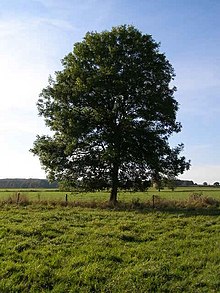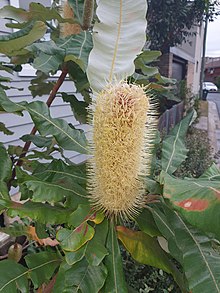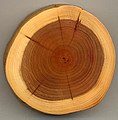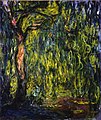The Trees Portal

In botany, a tree is a perennial plant with an elongated stem, or trunk, usually supporting branches and leaves. In some usages, the definition of a tree may be narrower, including only woody plants with secondary growth, plants that are usable as lumber or plants above a specified height. In wider definitions, the taller palms, tree ferns, bananas, and bamboos are also trees.
Trees are not a monophyletic taxonomic group but consist of a wide variety of plant species that have independently evolved a trunk and branches as a way to tower above other plants to compete for sunlight. The majority of tree species are angiosperms or hardwoods; of the rest, many are gymnosperms or softwoods. Trees tend to be long-lived, some reaching several thousand years old. Trees evolved around 370 million years ago, and it is estimated that there are around three trillion mature trees in the world currently.
A tree typically has many secondary branches supported clear of the ground by the trunk, which typically contains woody tissue for strength, and vascular tissue to carry materials from one part of the tree to another. For most trees the trunk is surrounded by a layer of bark which serves as a protective barrier. Below the ground, the roots branch and spread out widely; they serve to anchor the tree and extract moisture and nutrients from the soil. Above ground, the branches divide into smaller branches and shoots. The shoots typically bear leaves, which capture light energy and convert it into sugars by photosynthesis, providing the food for the tree's growth and development.
Trees usually reproduce using seeds. Flowers and fruit may be present, but some trees, such as conifers, instead have pollen cones and seed cones. Palms, bananas, and bamboos also produce seeds, but tree ferns produce spores instead.
Trees play a significant role in reducing erosion and moderating the climate. They remove carbon dioxide from the atmosphere and store large quantities of carbon in their tissues. Trees and forests provide a habitat for many species of animals and plants. Tropical rainforests are among the most biodiverse habitats in the world. Trees provide shade and shelter, timber for construction, fuel for cooking and heating, and fruit for food as well as having many other uses. In much of the world, forests are shrinking as trees are cleared to increase the amount of land available for agriculture. Because of their longevity and usefulness, trees have always been revered, with sacred groves in various cultures, and they play a role in many of the world's mythologies. (Full article...)

Banksia dentata, commonly known as the tropical banksia, is a species of tree in the family Proteaceae. It occurs across northern Australia, southern New Guinea and the Aru Islands. Growing as a gnarled tree to 7 m (23 ft) high, it has large green leaves up to 22 cm (8.7 in) long with dentate margins. The cylindrical yellow inflorescences, up to 13 cm (5.1 in) high, appear between November and May, attracting various species of honeyeaters, sunbirds, the sugar glider and a variety of insects. Flowers fall off the ageing spikes, which swell and develop follicles containing up to two viable seeds each.
Banksia dentata is one of four Banksia species collected by Sir Joseph Banks in 1770, and one of the four species published in 1782 as part of Carolus Linnaeus the Younger's original description of Banksia. Within the genus, it is classified in the series Salicinae, a group of species from Australia's eastern states. Genetic studies show it is a basal member within the group. Banksia dentata is found in tropical grassland known as savanna, and associated with Pandanus and Melaleuca. It regenerates from bushfire by regrowing from its woody base, known as a lignotuber. (Full article...)Did you know? -
- ... that Gregory's tree (pictured), near Timber Creek in Australia's Northern Territory, bears inscriptions by 19th-century explorers and is registered as both a heritage place and an Aboriginal sacred site?
- ... that the Balderschwang Yew is possibly the oldest tree in Germany?
- ... that black truffles suppress plant growth around their host tree, creating an area that looks burned?
- ... that root extracts from the tree species Pycnanthus angolensis can be used to treat parasitic infections, such as schistosomiasis?
- ... that the lime trees of Duncliffe Wood are reputedly among the oldest living things in the county of Dorset?
- ... that trees of the New Guinea genus Finschia have stilt roots coming off the trunk up to 1.8 m (6 ft) off the ground?
- ... that in the early 1980s, a team of surveyors discovered the World War II-era Avro Anson Memorial near Clackline, Western Australia, which had been overgrown by shrubs and trees?
Selected article -
Sequoiadendron giganteum, also known as the giant sequoia, giant redwood or Sierra redwood is a coniferous tree, classified in the family Cupressaceae in the subfamily Sequoioideae. Giant sequoia specimens are the most massive trees on Earth. They are native to the groves on the western slopes of the Sierra Nevada mountain range of California but are grown around the world.
The giant sequoia is listed as an endangered species by the IUCN with fewer than 80,000 remaining in its native California. The tree was introduced to the U.K in 1853 and now there are around 5,000 mature trees. (Full article...)General images
Selected lists
Subcategories
Related portals
Associated Wikimedia
The following Wikimedia Foundation sister projects provide more on this subject:
-
 Commons
Commons
Free media repository -
 Wikibooks
Wikibooks
Free textbooks and manuals -
 Wikidata
Wikidata
Free knowledge base -
 Wikinews
Wikinews
Free-content news -
 Wikiquote
Wikiquote
Collection of quotations -
 Wikisource
Wikisource
Free-content library -
 Wikispecies
Wikispecies
Directory of species -
 Wikiversity
Wikiversity
Free learning tools -
 Wiktionary
Wiktionary
Dictionary and thesaurus
-

-

-

-

-
Random portal

Purge server cache



































































Recent Comments